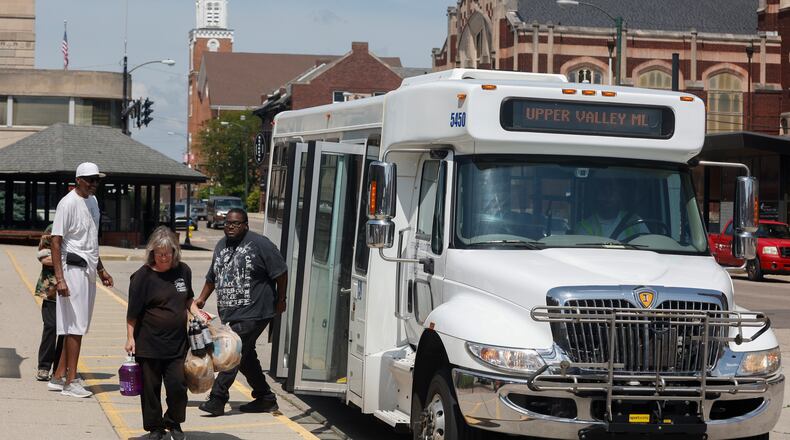There will be virtual bus stops and direct-to-door service for those with mobility challenges.
“This has been a discussion again as communities like Springfield look to find that efficient, effective and sustainable method to provide public transportation in the future for their communities,” Springfield City Manager Bryan Heck said at the most recent city commission meeting.
A soft launch of the new system is expected July 15, with a two-week overlap of the existing service as “we share information and transition riders to the new service,” Jason Via, Springfield’s deputy director of public safety and operations, said during Monday’s Springfield Rotary Club meeting.
Via said officials completed a review over the past several years of the existing system that included in-depth engagement, public engagement, ridership analysis, important feedback, and extensive evaluation of alternatives to improve access, equity, and efficiency.
“The clear takeaway from that effort is that our existing fixed route model no longer meets the needs of our residents or employers. Riders face long wait times and gaps in access to jobs and healthcare. Local businesses have expressed concern about aligning transit with workforce needs, and many individuals require a more flexible and responsive transit solution,” he said.
To address this issue, Via said micro-transit “emerged as a preferred solution.” He said this on-demand service will improve rider experience and set the city up for sustainable growth.
But SCAT employees, who spoke to the Springfield city commission on June 17, said they had not heard of the proposed change until two months ago and weren’t sure what to tell their customers who have a lot of questions.
“We are in limbo. We don’t know where our jobs are,” bus driver Cindy Longberry said. “The public wants to know what is going to happen.”
Some SCAT bus riders are concerned and confused, worrying for those who require mobility assistance.
What is the plan?
The new micro-transit system will work similar to rideshare apps like Lyft and Uber, but at the same price point as SCAT rides, it will be much more affordable, officials said.
Passengers will be picked up in branded Toyota Siennas, and riders will be paired with others headed in the same direction. “Virtual bus stops” at a convenient and safe location will be created for nearby riders, the company said previously.
Riders can book on-demand rides through a smartphone and tablet app, website and calls. Paratransit riders, those who need wheelchair-accessible vehicles, will have the ability to pre-book rides in advance. Riders will be able to pay by cash or credit card.
The new company, Via Transportation, aims to expand the transportation coverage area and be more flexible and responsive than the current system.
The system aims to expand access for older adults as well as disabled riders. Some of the 16 vans will be wheelchair-accessible with rear entry access.
“The new system will increase transit coverage to 100% while significantly lowering wait times,” said Clara Canales, project manager for Via Transportation. “Eliminating transfer riders will have a 6.5-fold increase into essential services and jobs which will really improve the quality of the service and hopefully access to essential services in this field.”
Via said existing routes run in circles all day and have predetermined stop times, which can provide a sense of safety and security, but that also means longer ride times. For example, you get on a bus and ride for 45 minutes to connect to another bus for 10 or 15 minutes, with a total travel time that could have been accomplished in less time.
“As far as efficiency, we’re going to gain a lot of (it) there,” he said.
A full fare for an end-to-end journey in the proposed new model is estimated to cost $2, or in some cases, a reduced fare of $1. Prices will remain the same for the current Springfield City Area Transit (SCAT) bus system for groups like students and for paratransit ($4).
The system is tailored to Springfield and will be similar to a service Via Transportation launched in Lorain County near Cleveland earlier this year.
Drivers will be locally hired at the same rate of pay as SCAT employees, Alex Lavoie, chief operating officer of Via Transportation, previously said. The company plans to seek SCAT bus drivers for the new system.
Canales said drivers will be “rigorously vetted and comprehensively trained,” and the number of driving roles will increase to about 25.
The city had originally hoped to launch the micro-transit program last year but did not receive proposals from companies pursuing the contract. A new request for proposals was ready to go out in September but was delayed when false rumors about Haitian immigrants in Springfield and subsequent bomb and personal threats burdened first responders and citizens, the city said previously.
Public shares concerns, asks for communication
A public meeting to discuss the major change originally scheduled for May 5 was canceled, with the city citing the need to finalize contract details before sharing more detailed information.
The city has mentioned the upcoming change at several meetings, including a work group session at a city meeting in April. The News-Sun has reported on the topic since 2023.
But some SCAT riders did not know about the change.
Those who were informed of the change had concerns.
Michael Williams, a former professional basketball player and Springfield resident, sometimes rides the bus three to four times a day during the week for things like grocery shopping and doctor’s appointments.
He said he heard the price for the new rides will be $4 one way, something he said many people, including those on fixed incomes, could not afford.
“I feel that the city hall within itself, the commission, all of that, they’re kind of letting this community down because a lot of people can’t afford that,” he said.
Williams said he was disappointed the public forum was canceled.
He said with the buses not running on weekends, riders “cram” shopping where they can Monday through Friday.
Via said the new service will run the same days and times as the existing service — Monday through Friday from 6:40 a.m. to 6:40 p.m. — until they can collect data and map out a path for expansion.
Some said the per-ride cost of about $2 will add up, and they weren’t sure if they would be able to buy passes for more rides at a discounted rate.
Some drivers, like Larry Hurd, feel the bus system works and there is no need for such a major change.
“We were told that there would be a public meeting held right here in city hall that would give us more details but that meeting was canceled and two months later, no one from the city that I know of has contacted any of our customers,” Hurd said. “No one has contacted any of our employees. No one has gone across the street. There’s the bus center right there. Just talk to people; get their opinion.”
Hurd gets questions from passengers about the change daily, he said.
“It’s frustrating that we have to look at them day after day and say, ‘We have no way to deal with it because no one has came over to explain anything to us,” he said.
Rhonda Moore, who retired two years ago from driving for SCAT for 31 years, showed a petition for which she was gathering signatures, though she did not share its specific purpose.
She said while visiting her brother who lives in a nursing home, she brought up her petition and no one knew what she was talking about.
“I’m really concerned because there’s going to be a lot of elderly people not being able to get in and out of places, because ... most of the people that rides the bus don’t even have a credit card,” Moore said, echoing concerns about the cost of the new system.
Where will SCAT drivers go?
Many drivers, like Hurd, feel uncertain about their future.
“Drivers have absolutely no idea what their job status is,” Hurd said. “Should they be looking for new work? Should they be staying? We have lost several drivers because, well they have no idea whether or not they have a future here.”
SCAT drivers have built connections with riders on their routes over the years, Longberry said, and take extra time to help those who need it.
“Are (micro-transit drivers) going to be willing to give the time that we do with our passengers?” Longberry said. “Yes, we don’t have a lot of time on our routes, but we take that time because we are a small community.”
Longberry and others repeatedly cited section 13 (c) of the Urban Mass Transportation Act of 1964. The law requires that “suitable fair and equitable arrangements be made to protect urban mass transportation industry employees affected by” the National Mass Transportation Assistance Act of 1974, which recognized the industry needed operating assistance to continue service.
The law requires unions representing employees affected to provide at least 60 days’ written notice of proposed changes that could lead to job loss or displacement. It also outlines the negotiations process and a displacement allowance.
Longberry said she is working 50 hours weekly right now “because our company won’t hire people because they don’t know what you guys are doing.”
“Do we need to go look for another job? Are you waiting for us to walk away?” Longberry said. “I’m not walking away. I have a commitment to my passengers.”
Via Transportation plans to encourage SCAT drivers to apply, it said previously.
“The current drivers, administrative staff, those folks are all employed by the current Transdev (SCAT’s parent company),” Jason Via said. ”We’ve been highly encouraging everyone to apply to the new system."
The lack of communication comes from Transdev, the city said. The company has been regularly updated about the micro-transit changes.
“It would be illegal for the city, since we are not your employers, to become involved in discussion of wages, hours, all of those issues that are part of collective bargaining, and if we were your employers, we would not be able to discuss collective bargaining issues publicly,” said Springfield Assistant Mayor and City Commissioner David Estrop.
“The contract we will vote on will be a contract ... with a company that operates the bus system and they in turn will engage in collective bargaining with their employees.”





